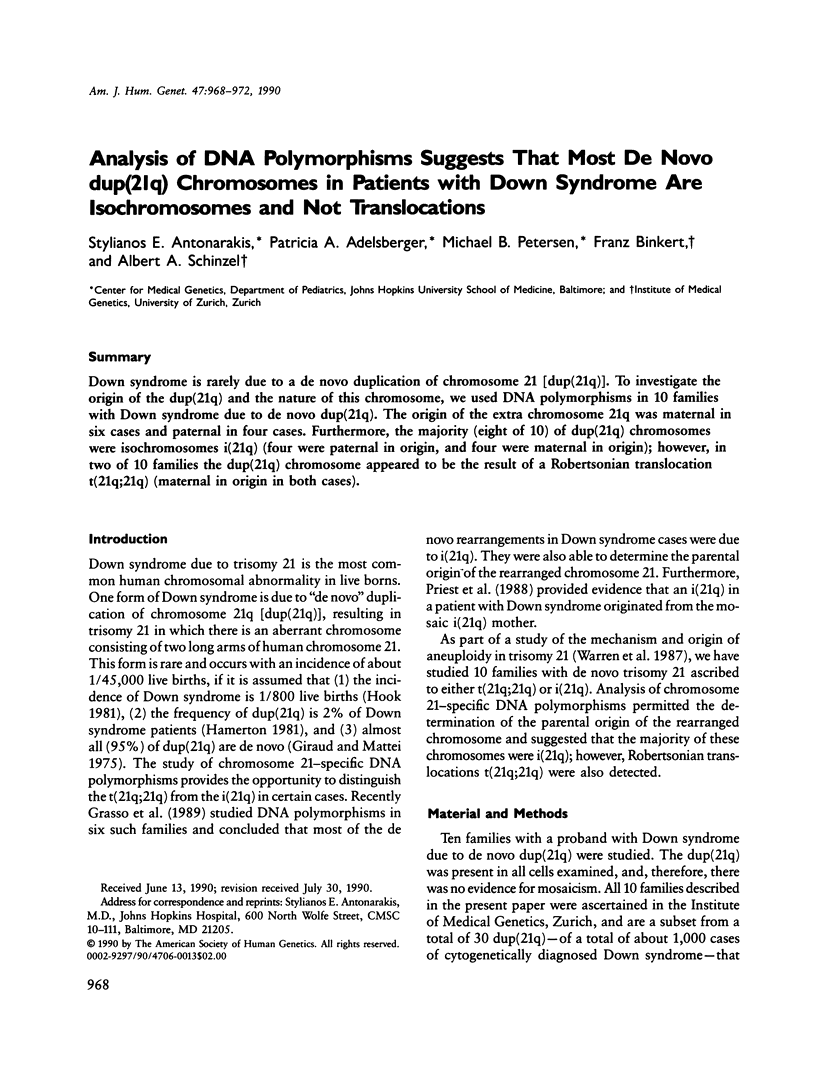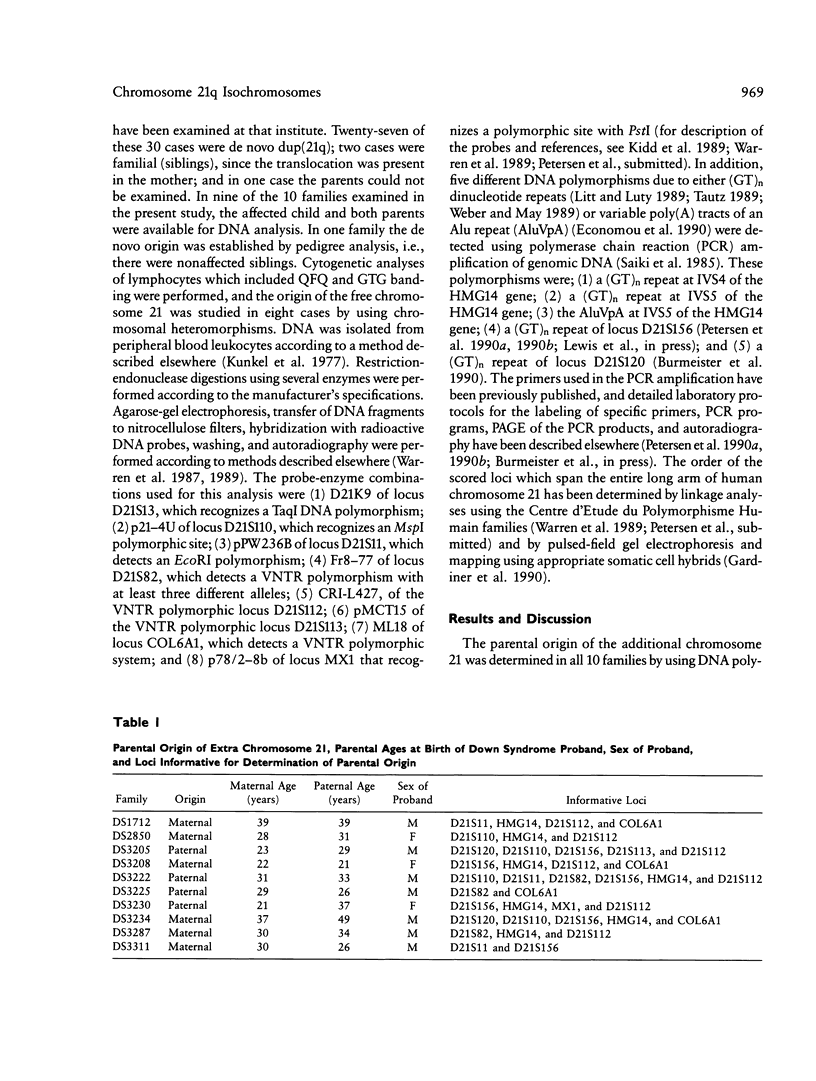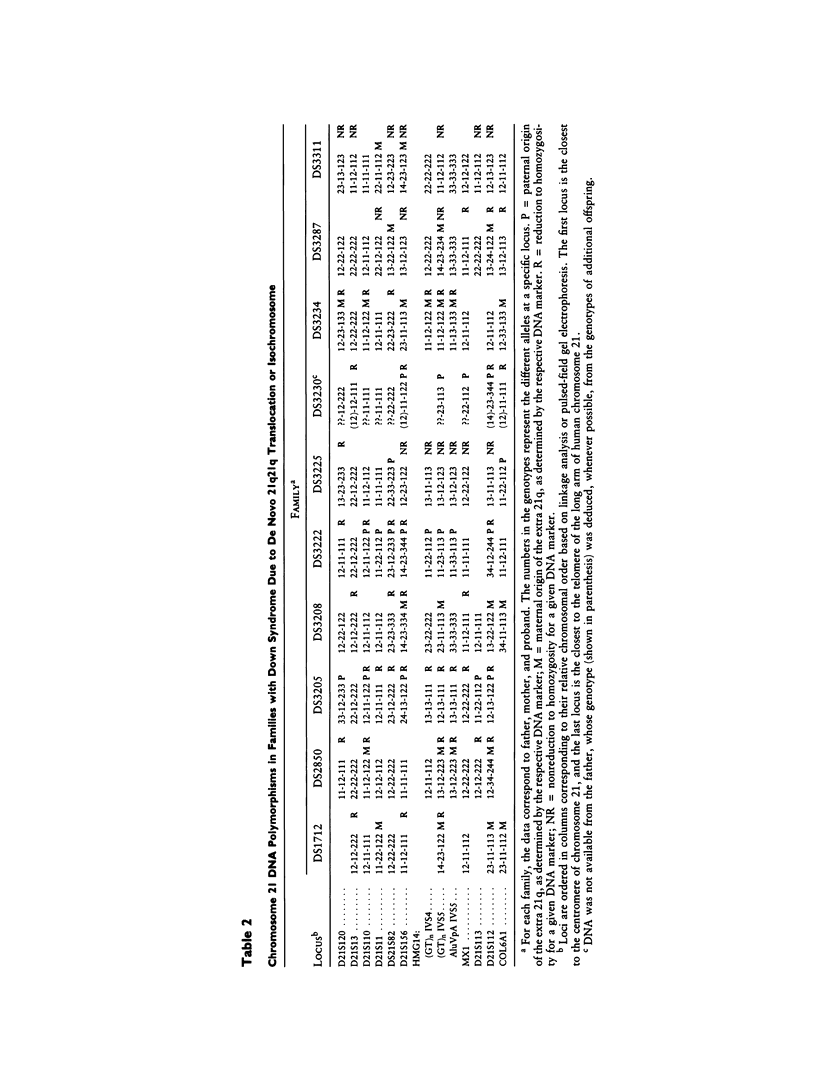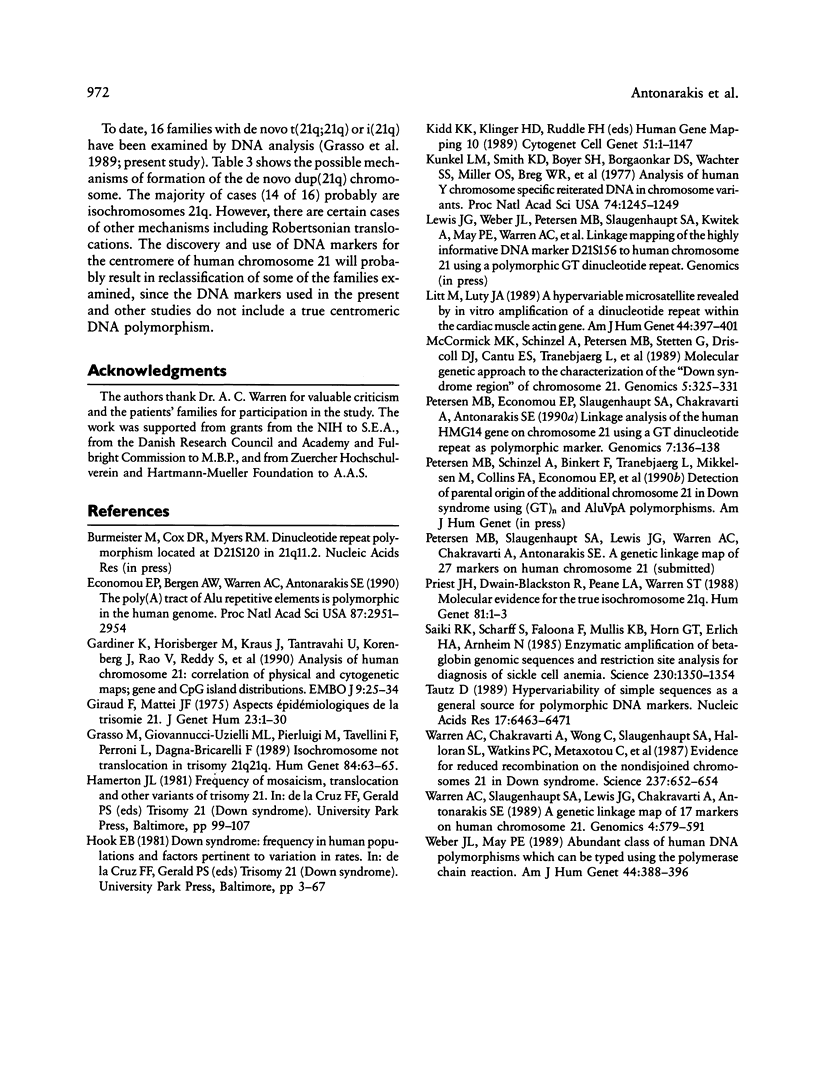Abstract
Down syndrome is rarely due to a de novo duplication of chromosome 21 [dup(21q)]. To investigate the origin of the dup(21q) and the nature of this chromosome, we used DNA polymorphisms in 10 families with Down syndrome due to de novo dup(21q). The origin of the extra chromosome 21q was maternal in six cases and paternal in four cases. Furthermore, the majority (eight of 10) of dup(21q) chromosomes were isochromosomes i(21q) (four were paternal in origin, and four were maternal in origin); however, in two of 10 families the dup(21q) chromosome appeared to be the result of a Robertsonian translocation t(21q;21q) (maternal in origin in both cases).
Full text
PDF




Selected References
These references are in PubMed. This may not be the complete list of references from this article.
- Economou E. P., Bergen A. W., Warren A. C., Antonarakis S. E. The polydeoxyadenylate tract of Alu repetitive elements is polymorphic in the human genome. Proc Natl Acad Sci U S A. 1990 Apr;87(8):2951–2954. doi: 10.1073/pnas.87.8.2951. [DOI] [PMC free article] [PubMed] [Google Scholar]
- Gardiner K., Horisberger M., Kraus J., Tantravahi U., Korenberg J., Rao V., Reddy S., Patterson D. Analysis of human chromosome 21: correlation of physical and cytogenetic maps; gene and CpG island distributions. EMBO J. 1990 Jan;9(1):25–34. doi: 10.1002/j.1460-2075.1990.tb08076.x. [DOI] [PMC free article] [PubMed] [Google Scholar]
- Giraud F., Mattei J. F. Aspects epidémiologiques de la trisomie 21. J Genet Hum. 1975 Oct;23(Suppl):1–30. [PubMed] [Google Scholar]
- Grasso M., Giovannucci Uzielli M. L., Pierluigi M., Tavellini F., Perroni L., Dagna Bricarelli F. Isochromosome not translocation in trisomy 21q21q. Hum Genet. 1989 Dec;84(1):63–65. doi: 10.1007/BF00210673. [DOI] [PubMed] [Google Scholar]
- Kunkel L. M., Smith K. D., Boyer S. H., Borgaonkar D. S., Wachtel S. S., Miller O. J., Breg W. R., Jones H. W., Jr, Rary J. M. Analysis of human Y-chromosome-specific reiterated DNA in chromosome variants. Proc Natl Acad Sci U S A. 1977 Mar;74(3):1245–1249. doi: 10.1073/pnas.74.3.1245. [DOI] [PMC free article] [PubMed] [Google Scholar]
- Litt M., Luty J. A. A hypervariable microsatellite revealed by in vitro amplification of a dinucleotide repeat within the cardiac muscle actin gene. Am J Hum Genet. 1989 Mar;44(3):397–401. [PMC free article] [PubMed] [Google Scholar]
- McCormick M. K., Schinzel A., Petersen M. B., Stetten G., Driscoll D. J., Cantu E. S., Tranebjaerg L., Mikkelsen M., Watkins P. C., Antonarakis S. E. Molecular genetic approach to the characterization of the "Down syndrome region" of chromosome 21. Genomics. 1989 Aug;5(2):325–331. doi: 10.1016/0888-7543(89)90065-7. [DOI] [PubMed] [Google Scholar]
- Petersen M. B., Economou E. P., Slaugenhaupt S. A., Chakravarti A., Antonarakis S. E. Linkage analysis of the human HMG14 gene on chromosome 21 using a GT dinucleotide repeat as polymorphic marker. Genomics. 1990 May;7(1):136–138. doi: 10.1016/0888-7543(90)90531-x. [DOI] [PubMed] [Google Scholar]
- Priest J. H., Blackston R. D., Pearse L. A., Warren S. T. Molecular evidence for true isochromosome 21q. Hum Genet. 1988 Dec;81(1):1–3. doi: 10.1007/BF00283718. [DOI] [PubMed] [Google Scholar]
- Saiki R. K., Scharf S., Faloona F., Mullis K. B., Horn G. T., Erlich H. A., Arnheim N. Enzymatic amplification of beta-globin genomic sequences and restriction site analysis for diagnosis of sickle cell anemia. Science. 1985 Dec 20;230(4732):1350–1354. doi: 10.1126/science.2999980. [DOI] [PubMed] [Google Scholar]
- Tautz D. Hypervariability of simple sequences as a general source for polymorphic DNA markers. Nucleic Acids Res. 1989 Aug 25;17(16):6463–6471. doi: 10.1093/nar/17.16.6463. [DOI] [PMC free article] [PubMed] [Google Scholar]
- Warren A. C., Chakravarti A., Wong C., Slaugenhaupt S. A., Halloran S. L., Watkins P. C., Metaxotou C., Antonarakis S. E. Evidence for reduced recombination on the nondisjoined chromosomes 21 in Down syndrome. Science. 1987 Aug 7;237(4815):652–654. doi: 10.1126/science.2955519. [DOI] [PubMed] [Google Scholar]
- Warren A. C., Slaugenhaupt S. A., Lewis J. G., Chakravarti A., Antonarakis S. E. A genetic linkage map of 17 markers on human chromosome 21. Genomics. 1989 May;4(4):579–591. doi: 10.1016/0888-7543(89)90282-6. [DOI] [PubMed] [Google Scholar]
- Weber J. L., May P. E. Abundant class of human DNA polymorphisms which can be typed using the polymerase chain reaction. Am J Hum Genet. 1989 Mar;44(3):388–396. [PMC free article] [PubMed] [Google Scholar]


